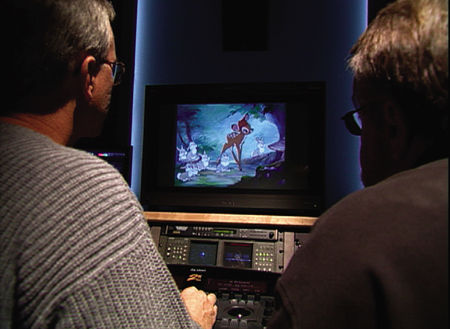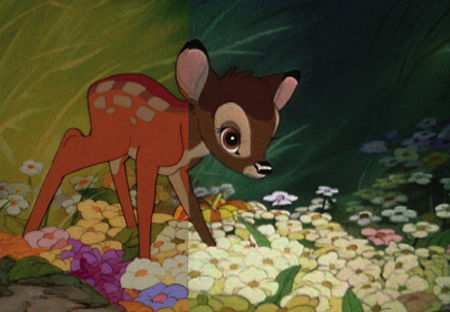Disney's Dave Bossert

Disney Studios has produced a great number of animated classics over the years. How do they decide which films to take out of the vault and restore?
As part of the restoration team, we work off a list of films that is based on a predetermined release schedule from Buena Vista Home Entertainment. This is how we decide which film is worked on at any given time.
What are the steps in the restoration process?
There are a number of steps in the Disney restoration process. We start with retrieving the original nitrate negative from storage. We store many of the nitrate negatives of Disney classic films at the Library of Congress film-storage facility in Ohio. The negative is returned to Los Angeles, and we thoroughly inspect it for any damage and then clean it. Then we film-scan the entire negative with each frame scanned at a 4K resolution. We archive the raw digital scans so that we have a complete digital version of the original negative. Then we put duplicate files of these scans through a process of full digital cleaning, which includes removing dust, dirt, cel shimmers, cel reflections, exposure variations, and other anomalies. After we complete this process, the restoration team views the images and usually calls out additional notes. When all notes are addressed, the team reviews the film again to make sure nothing has been missed.
At this point, we hand off the film to our color experts, Bruce Tauscher and Tim Peeler, for the final color adjustment, or, as it's called, "timing." When the color timing is completed, the entire team views the film again for final approval.

How long did it take to restore Bambi?
It took 9,500 man-hours to restore all 110,000 frames of the entire film.
Was there any new research involved?
There were several months of research concerning how the original film was created.
What are some of the biggest challenges your creative team has to face when you renovate an older film like this?
The biggest challenge for this type of restoration is making sure that the negative is intact to begin with. These early films were shot on nitrate film stock, which is an unstable material that has a natural chemical breakdown over time. Essentially, the nitrate negative dies a slow death, and it varies at to when it actually starts to decay.
It has been said that one of the toughest things to sell to an audience is a human figure. What is it about Bambi's character, a young deer, that makes his possession of a human-like soul believable?
I think that what makes Bambi's character such a believable human-like soul is his eyes. Bambi's eyes are so expressive and have so much life in them. Marc Davis, one of the Nine Old Men, was responsible for blending human-like expressions onto realistic deer characters.
Sleeping Beauty was released in 1959, and Bambi in 1942. was the Bambi restoration more intense? Yes, the restoration was much more challenging on Bambi than it is on films that were made in later years. One of the main reasons is that the artists at Disney were inventing the entire process of feature animation, and all of the aspects weren't in place when Bambi was made.

With all the computer-generated Technology That Is available, what do you see as the future of hand-drawn animation?
I think both computer-generated and hand-drawn animated films will continue to coexist as legitimate forms of film entertainment. The computer has proved itself as another great tool for the animation artist to use to create films.
What are the chances that one technology might overshadow or surpass the other?
It will be up to the animation visionaries as to which technique to use for their particular projects, as each technique—computer-generated and hand-drawn animation—has its pros and cons. Today, a number of hand-drawn animated films are in production or have recently been released, such as Disney's Pooh's Heffalump Movie. Also, the Japanese animator Hayao Miyazaki has released his latest hand-drawn film, Howl's Moving Castle, and it is one of the biggest, highest-grossing films in Japan.
Again, animation is an art form that has many different techniques that the artist can employ to create an entertaining film experience. Those techniques will ebb and flow in the coming years.
It seems as if recent animated features have appealed to adult audiences as much as they Have TO children. What is it about these films that makes them so engaging to an older audience?
Many Disney animated films have stories that resonate with our audiences, young and old alike. These films, such as Bambi and Aladdin, have stories that deal with subject matter that many people can relate to, like the death of a parent or falling in love. Many of the Disney films are about hope, that there is always hope and light at the end of the tunnel.

In a recent issue of Los Angeles magazine, there was an article about Pixar and its lack of respect from Hollywood. The author poses the argument that the animated medium has not been recognized as a valid art form in the arena of live-action film. What are your feelings about how animated features, and their creators, should be recognized by the Academy of Motion Picture Arts and Sciences?
As a member of the Academy of Motion Picture Arts and Sciences, I can say that the Academy does recognize animation as a valid art form. Disney has received dozens of Academy Awards for its animated shorts and features over the years. Disney was the recipient of the first Academy Award for Best Short Subject for Flowers and Trees in 1932. The Disney animated feature Beauty and the Beast was nominated for Best Picture in 1991. Most recently, the Disney short Lorenzo was nominated for Best Animated Short in 2004. In recent years, the Academy has instituted a Best Animated Feature Film category and continues to celebrate animation as a part of the film industry.
- Log in or register to post comments




































































